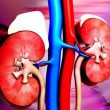The new drug-eluting stents (DES) equipped with ultra-thin struts are showing a lower risk of target lesion failure as a result of lower rates of acute myocardial infarction and similar rates of revascularization, according to this meta-analysis soon to be published in Circulation. Such a difference is evidenced at a 1-year follow-up when compared with...
FFR vs Angiography Guided CABG
In the daily practice and in randomized studies such as Syntax or Freedom, most cardiovascular surgeons across the world use angiography guided CABG to teat 50% coronary stenosis. Many of these lesions might not be functionally significant. There is abundant evidence in favor of fractional flow reserve (FFR) guided PCI, but FFR guided CABG is...
Renal Impairment: How Does It Affect Angioplasty and Surgery?
Courtesy of Dr. Carlos Fava. The incidence of kidney disease is increasing. In its final stage, this pathology is related with coronary disease and increased mortality. Furthermore, we know that, in many occasions, it is associated with diabetes. Nowadays, the evidence comparing the progress of patients with impaired kidney function who have undergone left main...
Angina Is as Subjective as Any Other Pain
Almost 80% of all patients randomized in this study reported Canadian Cardiovascular Society class II or III angina, and almost all of them (97%) had more than 1 positive non-invasive ischemia test that matched the area of their single diseased coronary vessel. Beyond fractional flow reserve (FFR) or instantaneous wave-free ratio (iFR), the study randomized patients to...
EuroPCR 2018 | Consistent CTO Study: Rechanneling with Current Techniques and SYNERGY Stents
This observational study included 231 patients from 6 sites who presented chronic total occlusions and underwent rechanneling procedures using currently available techniques, which were successful in 90% of all cases (210 patients). All patients who underwent successful rechanneling received a SYNERGY stent and most of them underwent intravascular ultrasound (90.5%). There was only 1 patient lost to clinical follow-up...
EuroPCR 2018 | SYNTAX II: Results at 2 Years for Best Angioplasty vs. Surgery in Multivessel Disease
Since the publication of the original SYNTAX trial, there have been great technical advancements that have influenced the results of angioplasty: New tools for risk stratification using the SYNTAX II score which integrate clinical and anatomical variables to the team’s decision-making process. Functional revascularization (hybrid use of fractional flow reserve or instantaneous wave-free ratio). Optimization of...
EuroPCR 2018 | DESSOLV III: Bioabsorbable vs. Durable Polymer at 2 Years
Most drug-eluting stents are coated by a polymer that is used to contain the antiproliferative drug. Once the drug is released, the polymer remains in place and its presence has been associated with inflammation, restenosis, and neoatherosclerosis. The MiStent device features a polymer that becomes bioabsorbable once the drug has been released, which could, theoretically,...
EuroPCR 2018 | Swedish Registry on the SYNERGY DES: tested in primary PCI for the first time
The study included 36292 consecutive patients undergoing acute myocardial infarction receiving PCI with the new generation stent SYNERGY (thin struts, bioresorbable polymer and everolimus eluting); 39.7% presented ST elevation MI. Kaplan-Meier curves at 2 years of patients receiving the SYNERGY vs patients receiving other drug eluting stents resulted very similar for thrombosis (0,69% vs 0,81%,...
EuroPCR 2018 | BIO-RESORT: Polymer vs. Bioresorbable Polymer; Have We Reached a Plateau with DES?
This study randomized 3514 patients to a thin-strut biodegradable polymer everolimus-eluting stent (SYNERGY) vs. a sirolimus-eluting stent (ORSIRO) vs. a durable polymer zotarolimus-eluting stent (RESOLUTE INTEGRITY). The combined endpoint, the rate of target vessel failure, was similar for all three devices (8.3% for the zotarolimos-eluting stent, 6.8% for the everolimus-eluting stent, and 6.6% for the sirolimus-eluting...
EuroPCR 2018 | FFR Reduces Death and Infarction Rates Compared with Medical Treatment
Pooled data from the most important recently published studies (FAME 2, Compare-Acute, and DANAMI3-PRIMULTI) conclude that there is a significant difference in favor of fractional flow reserve (FFR) as regards hard endpoints. Coronary revascularization guided by FFR reduces the risk of death and infarction when compared with optimal medical treatment in patients with stable and...









